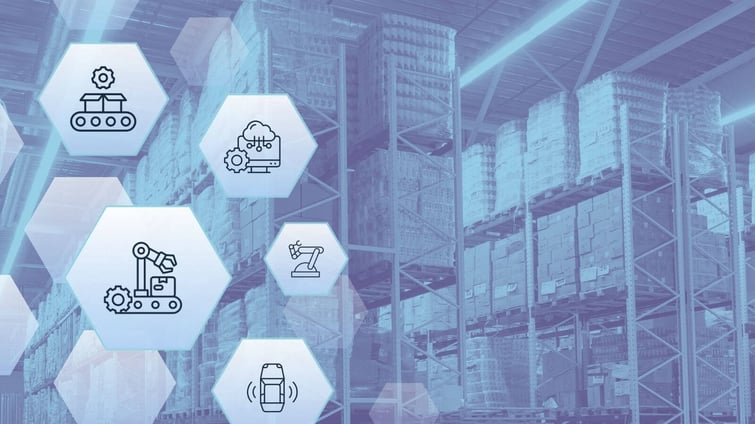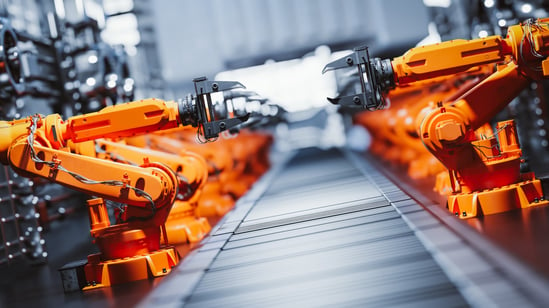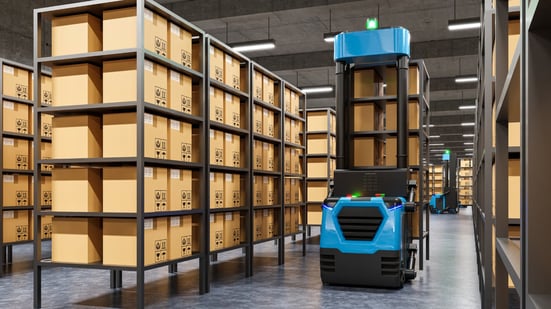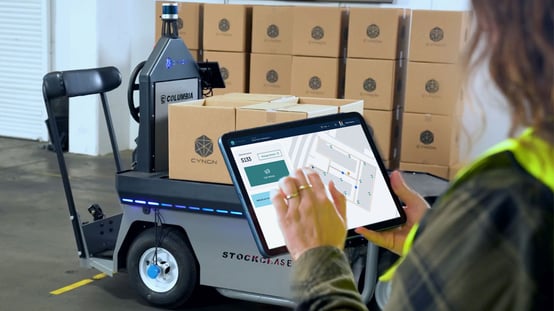4 Myths and Misconceptions in the AV Space
There are many myths and misconceptions surrounding the AV space. In this article, we debunk some of the most common ones.
In this article, we explore all things industrial automation — types, trends, and the benefits that have made it such an integral part of manufacturing.

What is industrial automation? Industrial automation is no longer a futuristic concept, but a present-day reality that is rapidly changing the way businesses, across all industries, operate.
Industrial automation involves the use of advanced technology to automate various stages of the manufacturing process, from material handling to final product delivery. Today, it is widely adopted across various industries, including manufacturing, automotive, healthcare, , among many more.
Following two decades of research, development, and beta testing, industrial automation has evolved past its initial stages. What started as simple mechanization of repetitive tasks, such as assembly line production, has progressed into sophisticated systems that integrate advanced technologies including artificial intelligence, machine learning, and robotics. As a result, with the advent of Industry 4.0 and the Internet of Things (IoT), industrial automation is expected to grow to 395.09 Billion by 2029, growing at a compound annual growth rate of 9.8%.
In this article, we explore industrial automation, the different types, as well as the benefits that have made it such an integral part of modern manufacturing.
.jpeg?width=550&height=309&name=industrial%20automation%20header%20(1).jpeg)
Industrial automation is the use of advanced technology and machinery to streamline industrial tasks and processes more efficiently and with reduced human intervention.
Essentially, it is the integration of various machines, sensors, and systems to automate manufacturing processes, supply chain operations, and other industrial tasks. This innovative technology offers organizations the ability to optimize their production processes, improve safety and quality, and reduce costs.
In particular, continued advancements in artificial intelligence, machine learning, and big data analytics are driving the evolution of industrial automation, resulting in the emergence of new applications across various industries. This has led to significant growth in the global industrial automation industry which was estimated at $196.6 billion in 2021 and grew to $213.49 billion in 2022 at a rate of 8.59%.
The key features of industrial automation are:
Control: It involves monitoring and adjusting the performance of the system based on feedback from sensors and other devices.
Feedback: It allows the system to detect and respond to changes in the environment.
Optimization: It involves analyzing data from the system to identify patterns and improve performance over time.
The integration of industrial automation into organizations’ processes has revolutionized the way work is carried out in many, if not most, industries. Some of the key industries fueling the growth of industrial automation include:
Specifically, these early adopters of industrial automation are carving out a competitive advantage and setting new industry process standards. However, not all industries have the same needs when it comes to automation. Instead, the level of flexibility, accuracy, and customization required varies between sectors.

Automation has continued to evolve over the past few decades to rapidly change the industrial landscape. To better understand the impact of this technology, let’s explore the four types of industrial automation with their unique characteristics and functionalities.
1. Fixed Automation
Fixed automation is the oldest form of industrial automation technology and it refers to the use of specialized equipment to perform a specific set of tasks. Fixed automation systems are built to complete a particular task repetitively without human intervention and cannot be reprogrammed.
Their ability to operate at high speeds makes them ideal for mass production applications, such as assembly line work, where the same operation is performed repeatedly.
For example, during automotive production, the production process is divided into several stages and each of these stages is carried out by a specialized machine. As a car moves along the assembly line, it passes through each stage of the production process and the machine at the given stage performs its specific function.
During the welding stage, for instance, a machine is used to fuse different parts of the car together. Similarly, in the painting stage, a machine will paint the car the desired color.
2. Programmable Automation
Programmable automation uses computer-controlled machines to control machinery or equipment in the production of goods. Unlike fixed automation, which is designed to perform a specific task or sequence of tasks, programmable automation is flexible and can be programmed to perform a range of tasks.
Specifically, Programmable Logic Controllers (PLCs) are a vital component of programmable automation, as they allow for the programming and control of different automated processes. They are used to automate processes, monitor the status of various components, and respond to changes in the production environment.
Programmable automation systems are ideal for industries that require a moderate level of customization in their production processes and specifically low-volume, high-variety production tasks. It allows organizations to swiftly switch between products or adjust processes to meet changing demands. For instance, CNC machines can be programmed to produce different parts by changing software instructions. Other examples include programmable industrial robots, industrial control systems, etc.
3. Flexible Automation
Flexible automation is an advanced form of industrial automation technology that offers higher customization and adaptability than other automation types. This type combines the benefits of both fixed and programmable automation using advanced robotic systems and automated systems that can perform multiple production tasks without human intervention.
Specifically, flexible automation systems are designed to be easily reprogrammed and can quickly adapt to changes in an organization's workflow or production requirements. In contrast to programmable automation, which uses software to control machinery, flexible automation relies on hardware that can be quickly reconfigured or modified to accommodate different products or tasks.
As a result, these machines are ideal for industries that require high levels of customization and frequent changes in production processes. Examples include collaborative robots (cobots), autonomous mobile robots (AMRS), automated guided vehicles (AGVs), and adaptive assembly lines.
One area where flexible automation has been making significant strides is self-driving technologies. Specifically at Cyngn, our autonomous stockchasers drive how you drive. This means that industrial vehicles running DriveMod can take commands, drive to different stations, start, stop, and adapt to the situation on the ground. If a facility needs to adjust its workflow or layout, DriveMod can swiftly adapt. Moreover, our AV technology comes with the ability to switch between manual and autonomous modes.
In addition, Cyngn Insight, our analytics tool, enables organizations to intuitively manage, monitor, and command their self-driving vehicles. This includes our autonomous Fleet Management System (FMS) which easily adapts to existing workflows, making it a flexible automation solution.
4. Integrated Automation
Lastly, integrated automation involves the use of multiple types of automation systems, such as fixed, programmable, and flexible automation, to optimize production processes.
Put simply, this type of automation is a more complex and comprehensive approach that combines different types of automation systems to create a unified production process.
More specifically, these systems use advanced computer software programs that coordinate the activities of various automated systems, including robots, conveyors, and other industrial automation solutions, to perform complex production tasks. Examples of integrated automation systems include computer-integrated manufacturing systems (CIM), smart factories, and cyber-physical systems.

Regardless of the specific type of automation, implementing this cutting-edge technology in different industries and sectors yields significant advantages. Let's explore how industries, particularly the manufacturing sector, are reaping the benefits of industrial automation.
1. Increased Productivity
Increased productivity is a significant advantage of industrial automation that can help manufacturers increase their output and efficiency. Specifically, automation helps optimize the manufacturing process by automating repetitive, mundane, and tedious tasks. This not only reduces the time required to complete a task but also increases product quality, while also improving worker retention.
Industrial automation further reduces the number of errors in the production line. Specifically, boredom associated with repetitive tasks can be linked to errors, safety issues, lower morale, and employee turnover. However, industrial automation can help companies achieve significant productivity gains by taking on these tedious and repetitive tasks, improving throughput and operational efficiency.
In fact, according to Cyngn’s research, the deployment of an AV at Global Logistics and Fulfillment’s Las Vegas warehouse facility led to a 33% increase in efficiency when using Cyngn’s autonomous stockchaser vs. using an electric pallet jack.
2. Improved Resource Utilization
Improved resource utilization is another benefit of industrial automation that can provide long-term benefits to manufacturers. By optimizing the use of resources such as energy, raw materials, and labor, industrial automation can significantly reduce waste and costs.
Additionally, automation tools can control the flow of materials, minimizing the use of raw materials and ensuring they are used efficiently. This can help in reducing costs and increase profitability for manufacturers.
3. Improved Consistency and Quality
When it comes to manual labor, human error, fatigue, and inconsistency in the workforce can lead to significant variations in quality. However, with the help of industrial automation, manufacturers can standardize the manufacturing process and eliminate these variations. By doing so, they are able to ensure consistent quality output.
Automated machinery, devices, and robots can perform tasks with consistent precision and accuracy to ensure that the products meet the same standards every time. They can work continuously and maintain a constant production rate and quality. Furthermore, industrial automation provides continuous control over manufacturing processes, allowing for rapid detection and correction of any deviations from standard procedures.
4. Decreased Downtime
In a manual labor environment, downtime can lead to delays and reduce the overall productivity of the production line. As a result, unplanned downtime can be particularly costly and disruptive to the productivity of a facility. Particularly, unplanned downtime can cost manufacturers as much as $50 billion a year.
Fortunately, industrial automation can reduce the likelihood and duration of downtime by working continuously without the need for human intervention, responding quickly to unplanned events, and mitigating the risk of human error. Additionally, automation tools can perform preventive maintenance which can fend off equipment failure and reduce the time required for maintenance.
5. Enhanced Safety and Working Conditions
Enhanced safety and working conditions are one of the most critical benefits of industrial automation. For instance, it is estimated that the number of forklift-related accidents alone totals nearly 100,000 per year and slips, trips, and falls are the number one reason for injuries in warehouses.
However, automated machines and devices can enhance safety by removing workers from hazardous tasks or dangerous environments that might not be safe for humans. This may include places with high temperatures or dangerous areas with lots of moving vehicles. By improving working conditions for workers, organizations can also reduce the stress and fatigue associated with demanding tasks.
As a result, prioritizing safety allows companies to decrease the costs associated with accidents, which can, in turn, enhance the quality of life for workers and create more satisfying work opportunities.
6. Combat Labor Shortages
Labor shortages rank in the top 4 greatest challenges facing manufacturing, transportation, and supply chain leaders, with over 50% citing employee retention as their single biggest challenge. According to a study by Deloitte, the failure to fill open positions in the manufacturing sector could cost the US economy more than $1 trillion.
Industrial automation is a key solution to combat the ongoing labor shortage as industrial AVs can take on repetitive tasks and transport routes. This is estimated to help free up 30%-50% of a skilled worker’s time. Companies can increase their production with fewer workers and at the same time assign their employees to more important and valuable tasks.
7. Reduce Costs and Waste
Another key benefit of industrial automation is its ability to lower costs and minimize wastage. By leveraging automation technology, companies can execute tasks with heightened precision and accuracy, resulting in reduced expenses for raw materials and minimized waste output.
Furthermore, industrial automation can curb labor expenses by reducing the workforce required in the manufacturing process. Automated machinery and equipment can efficiently perform tasks, keeping labor costs in check and boosting the productivity of the overall manufacturing process.
In fact, Cyngn’s research further showed that using an autonomous stock chaser at GLF in comparison to a pallet jack, led to a 64% reduction in labor costs.

As we have explored, industrial automation has already brought significant benefits to modern manufacturers, such that early adopters are already gaining a competitive advantage. However, as industrial automation continues to grow, we can anticipate further advancements in the future that will continue to help organizations across all industries revolutionize the way that work gets done.
Let’s explore how the innovative developments in industrial automation will continue to transform the manufacturing and industrial landscape.
One of the most significant trends in industrial automation today is the rise of collaborative robots, also referred to as "cobots." Cobots are designed to work alongside human operators and assist them with tasks that are too dangerous, repetitive, or physically demanding for people. For example, at Cyngn, we design our industrial autonomous vehicles to support a cobot workflow, working alongside the employees on the floor to increase productivity.
Over the past 70 years and particularly in the last two decades, AI has made significant strides. Now, artificial intelligence (AI) and machine learning (ML) are becoming increasingly important in the advancement of industrial automation. AI and ML algorithms help machines learn from data, adapt to new situations, and make better decisions on their own.
Specifically, AI can help industrial AVs tackle complex problems with greater accuracy and efficiency. It further helps organizations optimize production schedules, monitor equipment health, and predict maintenance needs before they become critical.
At Cyngn in particular, AI brings advantages to the perception modules of our autonomous vehicles — object detection and classification. By utilizing AI, Cyngn's vehicles are able to achieve safe and efficient driving in dynamic environments, the completion of unique tasks, semantic segmentation for accurate localization, and a cheaper and faster deployment bring-up.
B. New Business Models and Opportunities
The rise of industrial automation is also creating new business models and opportunities for companies. Some companies are offering Robotics as a Service (RaaS), a model that provides automated solutions on a subscription basis. As with any “as a service” model, this helps companies reduce capital expenditures and improve flexibility, as they can scale their automation needs as required.
With Cyngn’s RaaS offering, we help our customers easily overcome barriers to adoption. With RaaS, organizations can access our self-driving vehicle solutions on a monthly subscription basis, giving you the flexibility to scale your AV fleet up or down in response to changing demand.
Another opportunity is the rise of "digital twins" or virtual replicas of physical assets. Digital twins can be used to simulate and optimize industrial processes and allow companies to test different scenarios and make informed decisions before implementing changes in the real world.
C. Impact on Jobs and Employment
One common concern about the rise of industrial automation is the potential impact on jobs and employment. Specifically, this is the idea is that machines and robots will take over human jobs and leave people without work.
However, in reality and as we’ve explored, automation can create new jobs and increase worker retention by taking on repetitive, mundane, and dangerous tasks. This in turn fosters a safer environment for workers and creates more satisfying work opportunities for employees who can now focus on higher value-adding jobs.
This shift, therefore, helps to retain workers and allows organizations to augment their workforce to achieve greater productivity with enhanced safety. Additionally, this growth can lead to new jobs in areas such as product development, marketing, and logistics.
As we've explored, industrial automation is a powerful tool that is transforming industries across all sectors and benefiting companies, workers, and consumers alike. By implementing innovative machines and technology, organizations are able to achieve higher productivity and output, revolutionizing the way that their work gets done.
As a result, companies that leverage the benefits of industrial automation and adopt these systems are gaining a competitive advantage and better positioning themselves to compete in an increasingly globalized and rapidly changing business environment.
To learn more about Cyngn’s industrial autonomous vehicle solutions, please visit www.cyngn.com.
There are many myths and misconceptions surrounding the AV space. In this article, we debunk some of the most common ones.
AVs are playing a major role in shaping the future of manufacturing, allowing companies to stay competitive and address the industry's largest...
Safety is crucial when deploying AVs to mitigate risks to both workers and assets. In this article, we outline effective measures to ensure maximum...